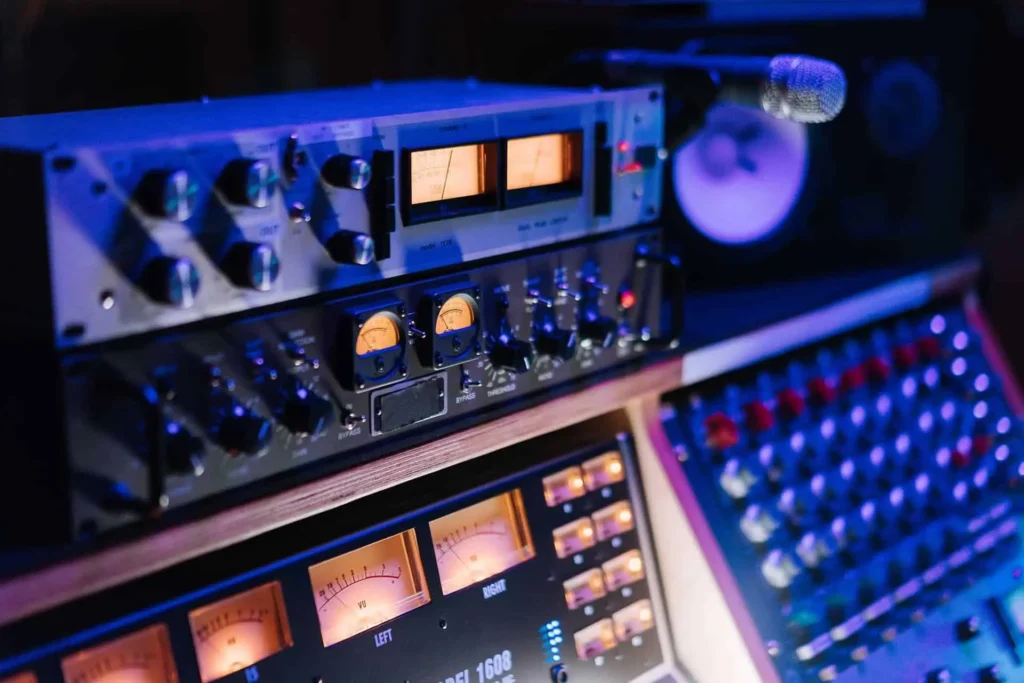There’s no doubt that brands spend months perfecting their image, graphic design, and storytelling to stand out from the crowd. However, when it comes to music, many make a decision in a matter of minutes and settle for generic tracks that can be found everywhere. In other words, it’s a strategic mistake… Underestimating the power of sound means missing out on a powerful lever that could make all the difference.
1. Generic music: a false good idea
Take the case of royalty-free sound banks, which can often be a handy solution. However, despite their practicality, they do more harm than good to the brand. Why?
You look like everyone else
When you use music that has been heard thousands of times before, you lose your uniqueness. If your competitor uses the same track or if your audience has already heard it in a food commercial, a travel video, or a YouTube tutorial, your brand loses all its uniqueness.
Poorly chosen music can undermine your message
Overall, a lot of royalty-free music is mass-produced without any particular intention. It is generic, impersonal, and often ill-suited to the values and emotions your brand wants to convey. A poor choice of sound can create a disconnect with your message and make your content bland or even incoherent.
A “cheap” effect that undermines your image
Imagine an advertisement for a luxury watch, but this time accompanied by cheap stock music. Immediately, the sensory experience loses its coherence; as a result, the brand image suffers. What’s more, consumers perceive these inconsistencies, sometimes unconsciously, which undermines their confidence. Furthermore, this dissonance not only impacts their immediate perception, but also reduces their long-term attachment to the brand. Therefore, choosing the right sound identity is essential to reinforce the brand’s emotion and credibility.

2 A well-designed sound identity: a strategic asset
Conversely, brands that invest in a strong sound identity create an immediate competitive advantage. Sound affects memory and emotion more quickly and deeply than images alone.
Sound influences the perception of your brand
Neuroscience studies have proven that music activates areas of the brain linked to emotions and memory. As a result, a well-thought-out musical signature instantly triggers positive associations. What’s more, it reinforces the impact of your message, improving the connection with your audience
Let’s take two concrete examples:
- An ethical and committed brand that opts for sterile electronic music risks losing credibility.
- Conversely, a dynamic brand that is completely disrupting its market and uses music that is too slow and melancholic sends a contradictory message to its audience.
A unique sound makes your brand instantly recognizable
When a brand has a strong sound identity, it becomes more easily identifiable, even without images. As a result, it stands out from the competition and strengthens its reputation. What’s more, this distinctive element encourages engagement by creating an immediate connection with its audience.
Think of brands that take care of their sound universe:
On the one hand, a cosmetics company that creates a musical territory inspired by nature reinforces its eco-responsible positioning. On the other hand, a tech start-up that uses clean, modern sounds anchors its image in innovation and simplicity. Finally, a retailer that plays a tailored playlist in its stores improves the customer experience and, as a result, encourages purchases. Thus, a well-thought-out sound identity becomes a real strategic lever for enhancing brand image and capturing the public’s attention.

3. Why generic music is toxic for your brand
In reality, the choice of music should never be left to chance, because the wrong choice of sound can create unconscious rejection among consumers.
A loss of advertising impact
If your employer branding video on social media or your advertisement uses generic music, it becomes interchangeable with thousands of others. It blends into the background noise and has no memorable impact.
The result? Lower retention rates, less engagement, and reduced memorability.
A weakening of brand image
A consistent and distinctive sound identity is a marketing asset. Conversely, banal or inappropriate music creates cognitive dissonance, which can damage brand perception.
Typical example: A high-end brand that uses overly generic music may unconsciously give the impression of a lack of authenticity or rigor in its approach.
A dilution of the emotional connection with your audience
Sound has the power to generate strong and lasting emotions. However, if your brand uses impersonal tracks that have already been heard elsewhere, then you are missing out on a valuable opportunity. In fact, you are missing the chance to create a genuine emotional attachment with your audience.
The result? On the one hand, less engagement. On the other hand, a decline in customer loyalty. Finally, it becomes more difficult to differentiate yourself in an ultra-competitive market.
Therefore, choosing a unique and authentic sound identity becomes essential to make an impression and strengthen the bond with your audience.

4. How to build an effective sound strategy?
Instead of randomly selecting stock music, it is better to adopt a three-step sound strategy. This will ensure consistency with your brand image while maximizing the emotional impact on your audience.
Define your sound territory
Before choosing a musical note, identify your brand’s values and sensory universe:
What is its DNA? (Emotional, bold, soothing, inspiring, etc.)
What is its positioning? (Premium, accessible, innovative, committed, etc.)
What type of sound best represents this universe? (Acoustic, electronic, orchestral, etc.)
Create a unique, tailor-made sound identity
A true musical identity is more than just a simple jingle. It must be designed to integrate into all your media:
Video & advertising: recognizable music that reinforces your storytelling.
Social media: a sound signature adapted to short formats.
Retail & events: an immersive soundscape that extends the brand experience.
UX & digital interfaces: sound design that improves interaction and navigation.
Deploy and optimize your sound identity
Once your musical identity has been defined, it must be integrated consistently across all touchpoints to create a seamless and impactful experience. Monitoring and optimization are essential to adapt the sound strategy to the brand’s evolution.

Conclusion: Generic music is a risky choice for your brand.
Underestimating sound means missing out on a powerful tool that could transform your communication.
A tailor-made sound identity allows you to:
Stand out from the competition.
Strengthen the impact of your message.
Increase brand recall.
Create a stronger emotional connection with your audience
So why settle for music that everyone else is using when you can have music that has been composed to embody your values and vision?
At Brandy Sound, we help brands create a strong and consistent sound identity. Because your brand deserves better than generic music.
We believe that audio branding is one of the keys to creating strong and desirable brands. Shall we talk about it?
Learn more
Want to make your brand memorable and iconic through audio branding? Contact us
